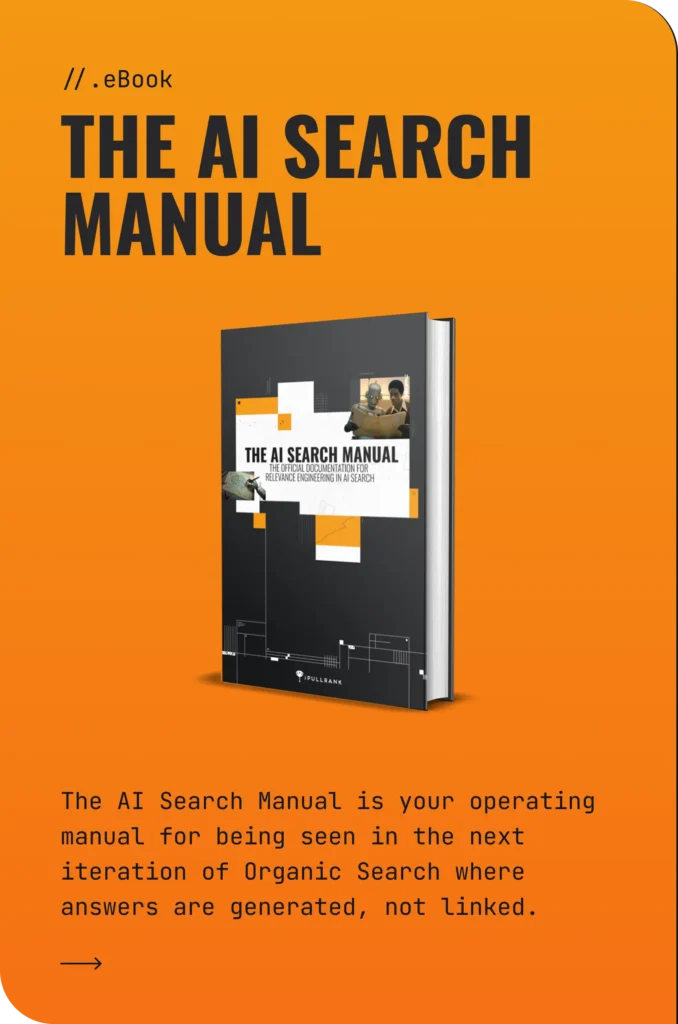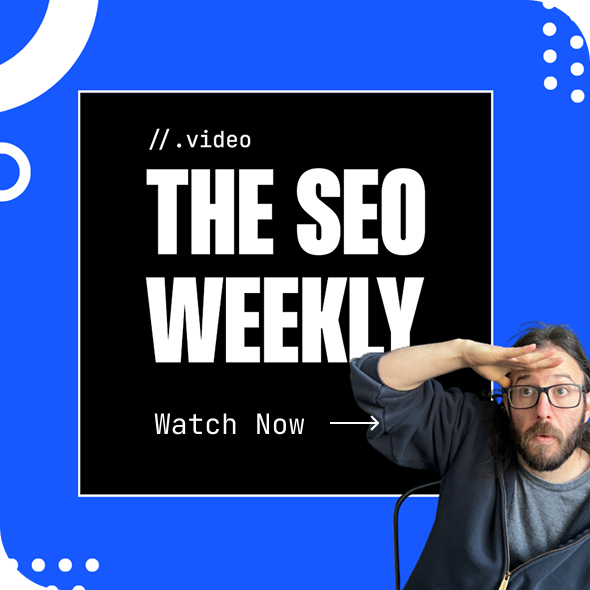Do you remember where you were when AI Overviews showed up like a guy who brought his guitar to a party without being asked?
Controversial, confusing, sometimes pretty inaccurate, but not going away anytime soon, AI Overviews (AIOs) emerged in May 2024 as Google’s answer to lowering the Delphic cost of search and providing searchers with immediate answers.
Originally introduced in 2023 as Search Generative Experience (SGE), these featured snippets on steroids quickly changed the SEO industry’s entire outlook on search. Quick, concise, and not requiring any clicks to other sites, AI Overviews have had an irreparable impact on website traffic, with clicks and impressions seeing a dramatic split in what many are now calling The Great Decoupling.
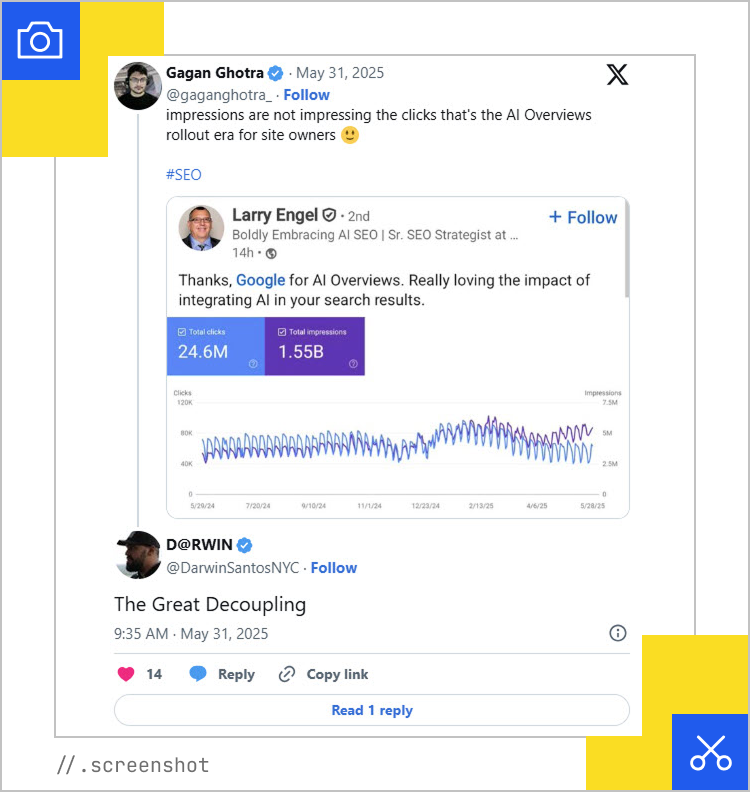
And the unreliable nature of AIOs and their misinformation even resulted in the first of what could possibly be more lawsuits holding Google responsible for incorrectly representing businesses, as well as lawsuits regarding AI’s copyright infringement.
Since their introduction, a flood of research has examined a number of factors including:
- Keyword Volume
- Industry
- Keyword Type
- AI Overview content analysis
- AI Overview citation analysis
- Device Type
- Search Intent
- Click Through Rate
- Volatility
- Traffic Impact
Here’s a comprehensive, chronological breakdown of what we have learned (and unlearned) about AIOs from the studies published to date.
AI Overviews from May to December 2024
Just after AI Overviews launched publicly on May 14, 2024, SEO agency Siege Media released an impact report to look at the potential effects they will have on search. At first, they actually reported seeing an increase both in impressions and clickthrough rate.
It’s a trend that wouldn’t last long but it’s funny to think that at first glance, the impact of AIOs was quite neutral:

AIOs in Informational Queries and the First Decreases in Traffic
A week later, Kevin Indig released a report on the traffic impact of AI Overviews that found:
- AIOs showed up 42% of the time (704/1,675 queries).
- Reddit was only #92 on the list of domains cited by AIOs (back in the good ‘ole days).
- AIOs are more likely to show up alongside Search Engine Results Page (SERP) features such as People Also Ask (PAA), Featured Snippets (FS) and Discussions & Forums modules (D&F), which also happen to appear mostly in informational searches (making this one of the first examples showing that AIOs appear more often for informational searches).
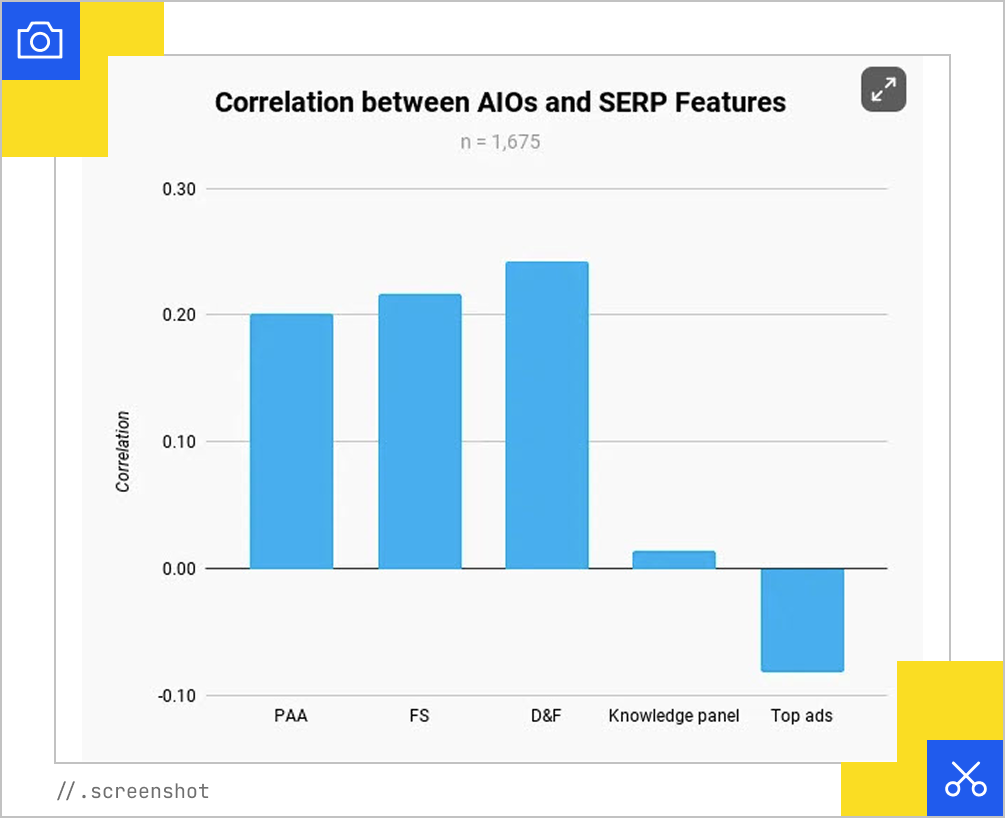
But what may be most important is that Kevin’s study found an indication of AIO citations sending fewer clicks to URLs, causing a decrease in traffic. The beginning of the end, if you will.
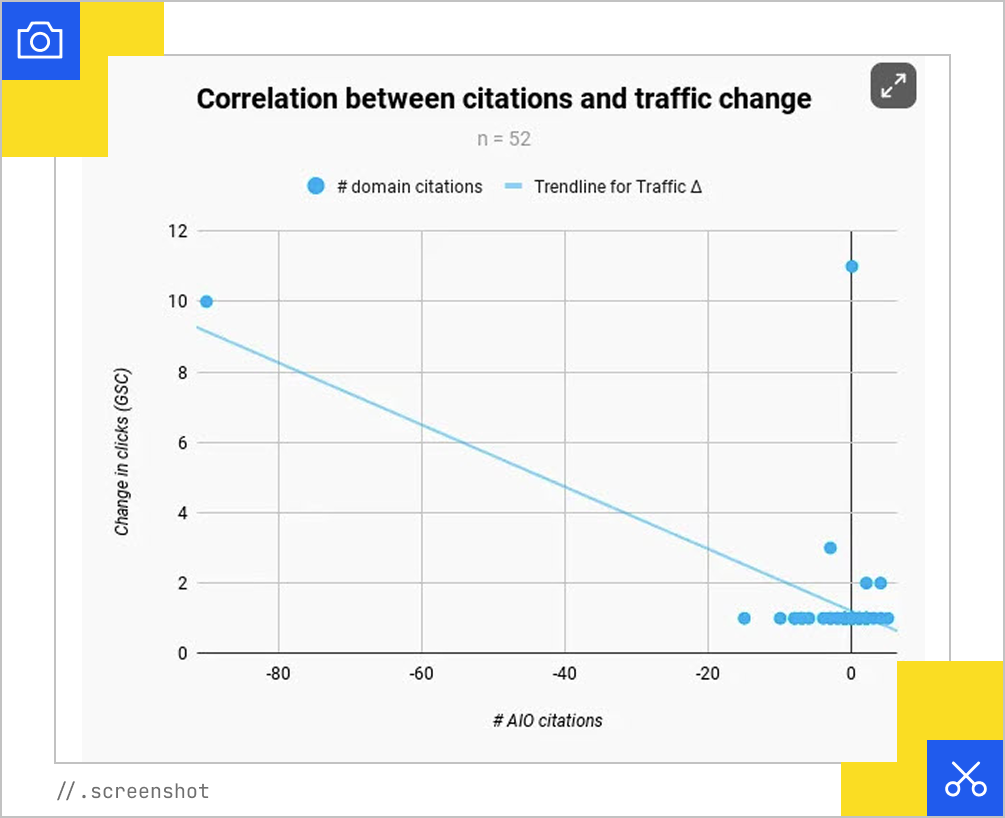
A couple of months later, SEO software company Advanced Web Ranking conducted an AI Overviews study on 8,000 keywords. They looked at 500 keywords from 16 different industries and grouped them into four search intents: Informational, Navigational, Commercial, and Transactional.
Their study found that AI Overviews appeared for only 12.4% of the 8,000 keywords analyzed.
Again, they continued to appear alongside other SERP features but rarely with Shopping Ads. Also, the links included within AI Overviews often directed users to sources that were not among the top 50 organic results for that query.
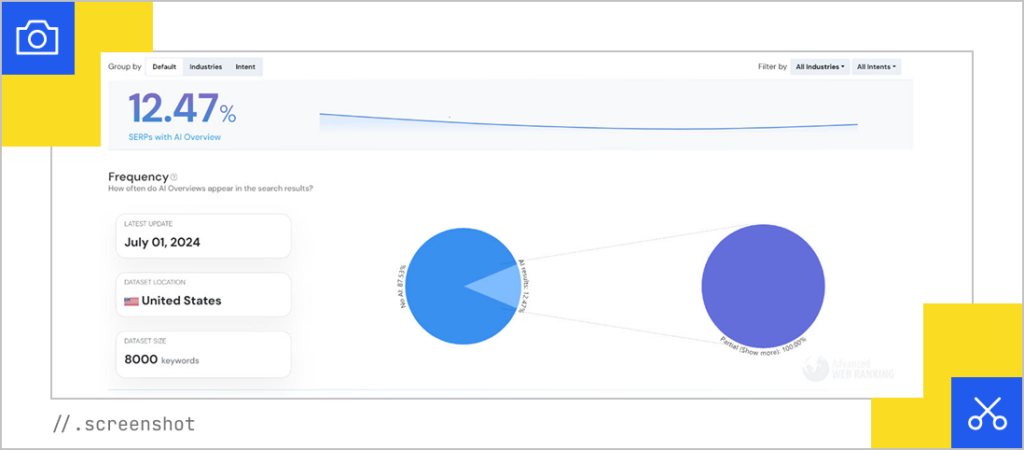
For informational queries, they found that AI Overviews appeared in 21.29% of cases. This is a continuation of a trend from the start of AIOs being better suited to answering informational queries.
The agency Flow confirmed this with their study on AIO trends:
- Top-of-funnel keywords were the most likely to have AI Overview appear coming in at 24% of the time.
- These keywords were primarily informational or educational content aimed at a broader audience.

As 2024 progressed, this became even more prevalent. In a study of 300,000 keywords, Ahrefs confirmed that 99.2% of keywords that triggered AI Overviews were ‘Informational’ in their intent, while AIOs only had a 10% chance of showing for commercial and transactional keywords.
The Rise of Conversational Search
That Ahrefs study also found a number of patterns that signaled the start of more conversational and semantic search by users:
- AIOs predominantly appeared for low-volume, long-tail keywords.
- AIO queries were long tail, containing four words on (median) average vs. two for standard searches.
- Keywords tended to be question focused.
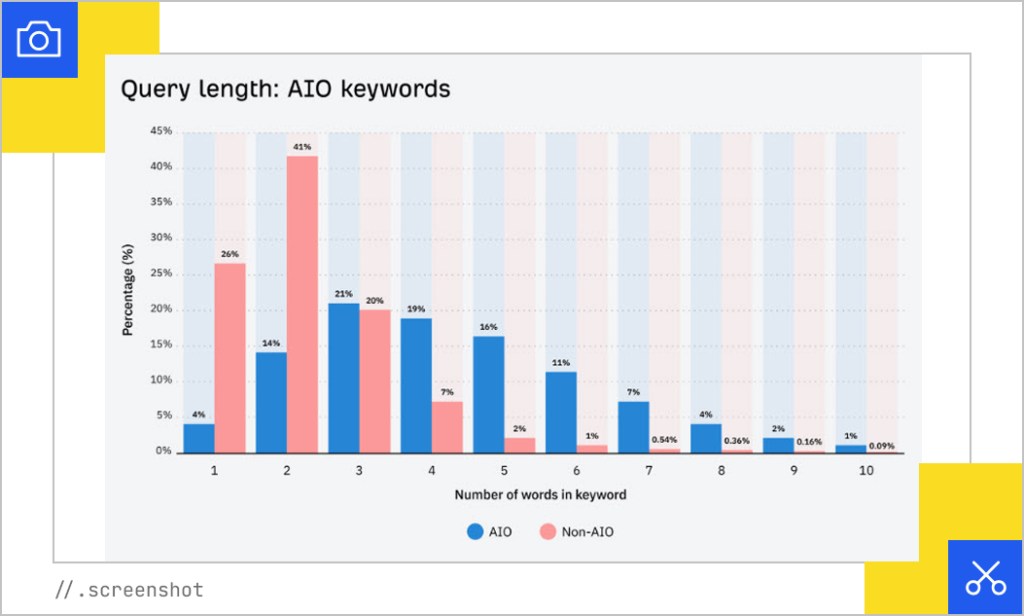
In October 2024, Semrush released another study about AIOs. They found that 80% of desktop and 76% of mobile AIOs targeted informational keywords in a continuing pattern, mainly in the health and science industries. This is no real surprise, as we know that the nature of AIOs is to provide informational summaries.
In fact, they found that from their sample of 200k keywords, 35% on desktop and 32% on mobile were questions beginning with who, what, why, when, how, etc., rather than navigational, transactional, or commercial intent.

Links in AI Overviews
A few months after his first study, Kevin Indig followed up by once again looking into URLs that appear in AIOs ranking outside the top 20 positions and this time he found that:
- 40% of URLs in AIOs ranked in positions 11-20, and half (21.9%) ranked in the top 3.
- The majority (60%) of URLs cited in AIOs still rank on the first page of organic results, reinforcing the point that a higher organic rank can increase the chance of being cited.
- It was basically impossible to be present in AIOs with a lower organic rank.
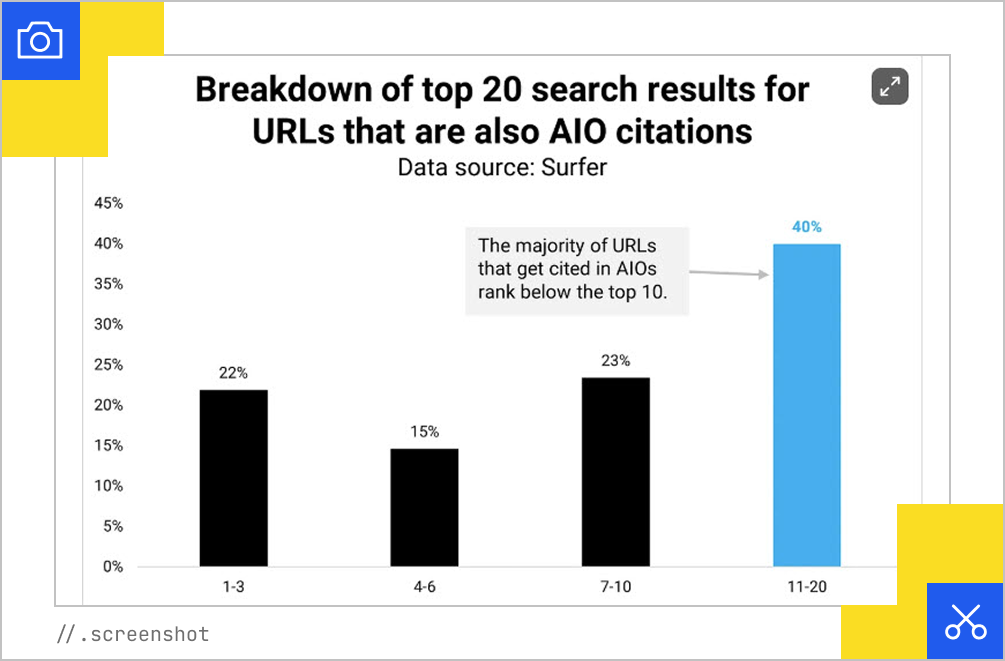
As Google began experimenting with including links within its AIO results, Semrush focused a study on the volatility of these links. They found that 91% of all URLs inside of the AI Overviews studied were removed at some point.
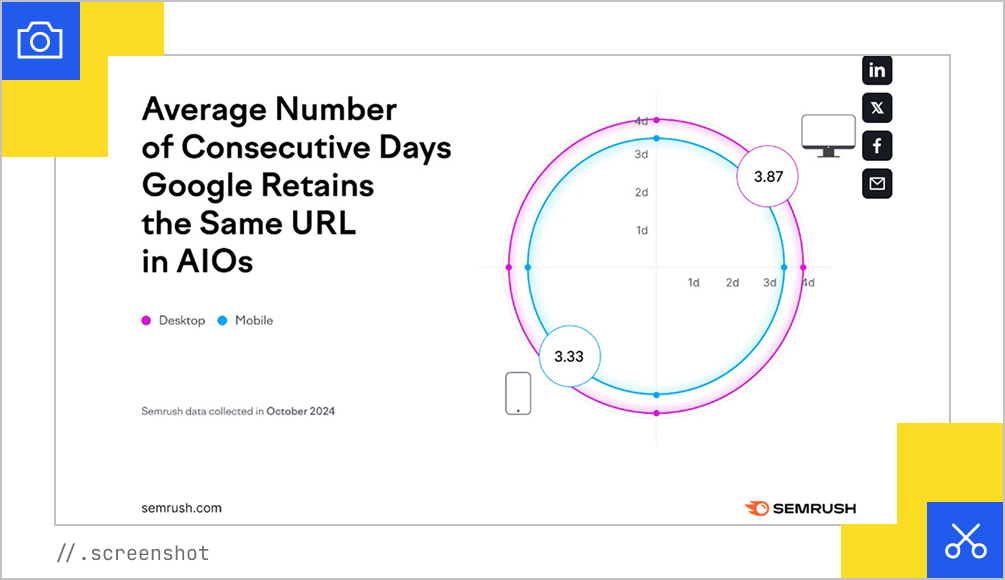
Surfer SEO later found some interesting stats about sources in their study, including:
- AI overviews mention an average of 5 sources per query.
- 90% of the time, Google lists 8 or fewer sources.
- 52% of sources mentioned by Google AI overviews rank in the top 10 results
- The sources mentioned by Google that also appear in the top 10 results of the SERP rank around position 5 on average.
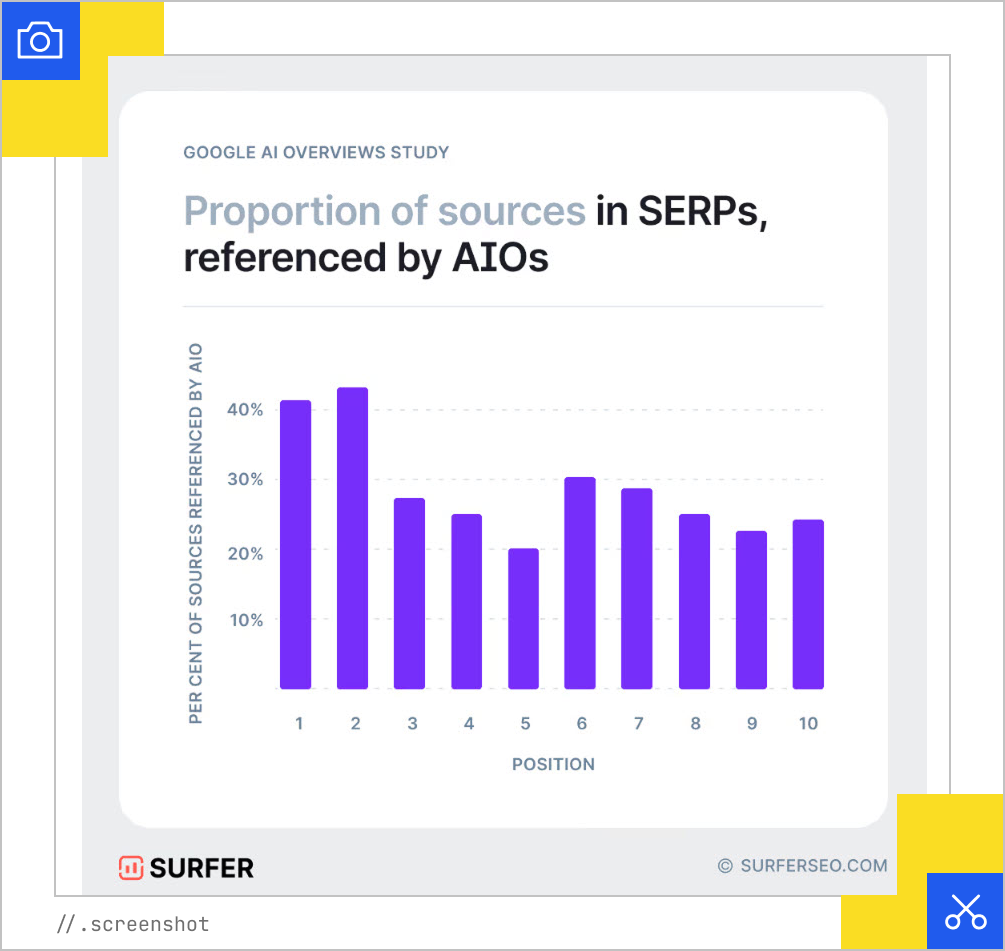
According to an SE Ranking study, AI Overviews showed a notable increase in prevalence by November 2024, reaching an 18.76% occurrence rate in the U.S. SERPs. They also found:
- AIOs overwhelmingly favored citing content from large, highly authoritative domains such as YouTube.com and Wikipedia.org.
- AIOs were consistently triggered by long-tail keywords, especially those with lower search volumes and lower cost-per-click (CPC) values.
- The average text length of AI Overviews nearly doubled to 5,337 characters by November.
They also tracked the distribution of AIOs across various industries and saw huge jumps over just a few months:
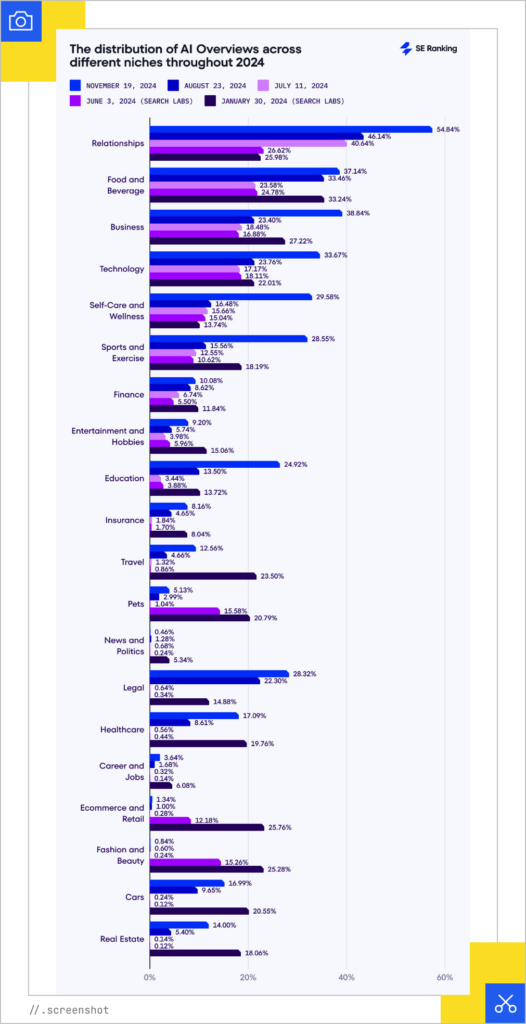
AI Overviews in January 2025 to the Present
At the beginning of 2025, Authoritas performed some studies about the SERP volatility and new emerging patterns. At this point, AIOs were still not showing up for the majority of searches or for terms with higher search volumes. Other stats they found included:
- AI Overviews were still very volatile and over 2 to 3 months you could reasonably expect 70% of the pages ranking in AIOs to change.
- There was a greater rate of change in pages ranking in AIOs than organic ranking pages.
- The pages ranking in AIOs changed independently of the organic ranking pages.
- The ranking pages in the AIOs changed independently of the generative AI Overview text snippet.
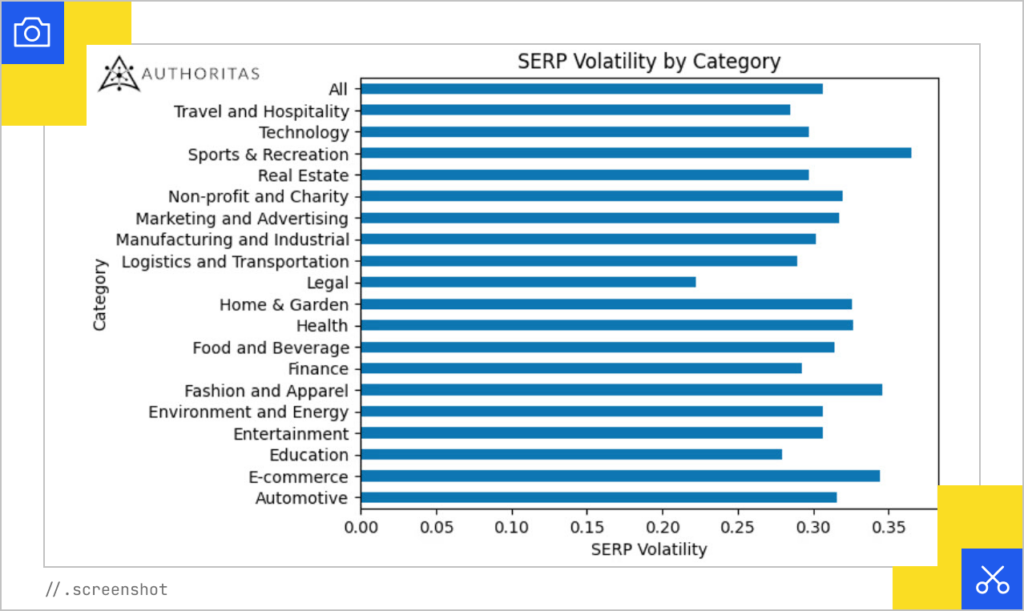
Seer Interactive looked at SERP volatility in April and found that the presence of AIOs bounced back and forth throughout the beginning of 2025:

The broad, top-of-funnel queries still showed the largest number of AIOs, but Seer was beginning to see more appear with specified TOFU searches including opinion-oriented, learning-based, and local terms.
Declining Click Through Rates
SEO agency Amsive performed their own study in April 2025 of 700K keywords throughout 5 industries. They found a continuing trend of declining click through rates, but not for branded keywords, among other realizations:
- Keywords that now trigger AIOs saw a CTR decline of -15.49% on average.
- Only 4.79% of branded keywords triggered AIOs.
- Branded keywords that triggered AIOs saw a CTR increase of +18.68% on average.
- For non-branded keywords, there was a CTR decline of -19.98% across the board.
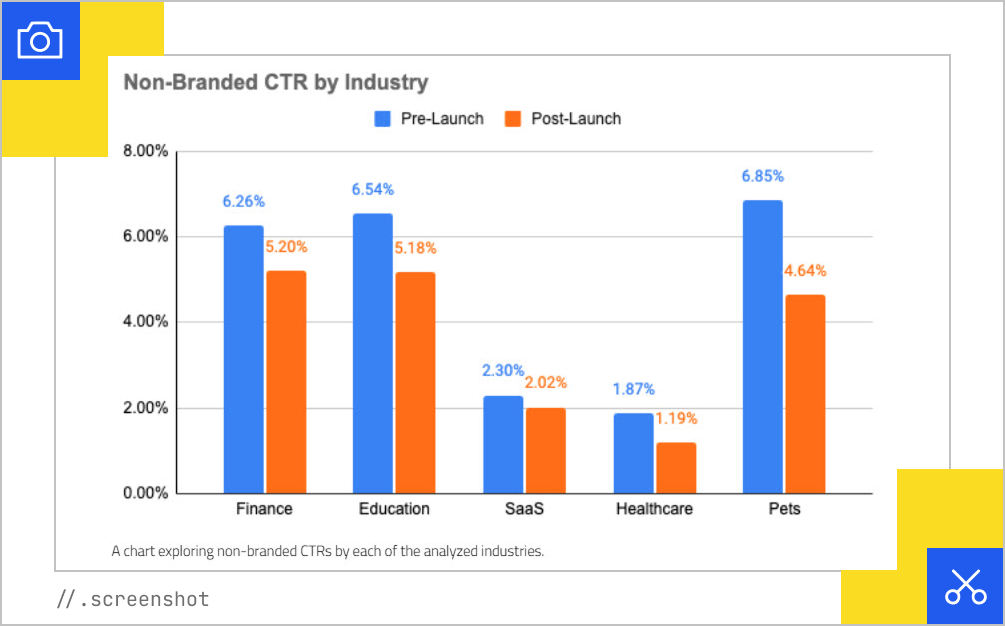
They also found that keywords that triggered both AI Overviews and Featured Snippets saw the largest drop in CTR, with an average decrease of -37.04%. This makes sense, though, when you consider how much real estate these features take up on the page while pushing down organic results.
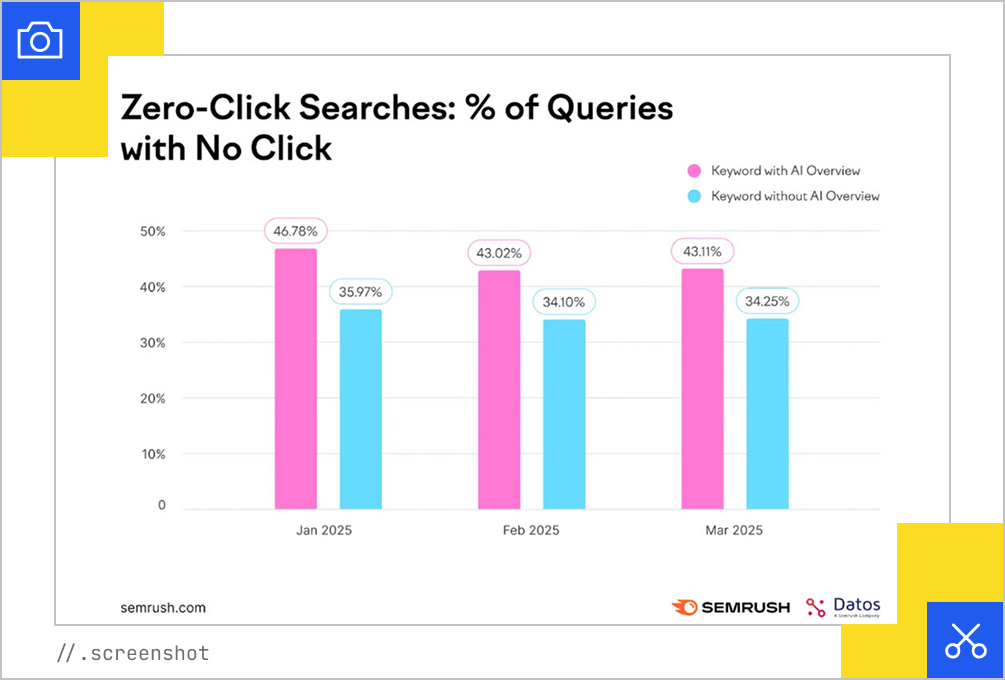
In May 2025, Ahrefs analyzed 56 million AIOs and found them appearing in 13.5% of all searches. The health and education sectors were impacted the most, while certain domains started emerging as citation favorites, including Wikipedia, Reddit, and Quora.
However, Ahrefs also found that when AIOs appeared, they reduced clicks by 34.5%. The traffic seemed to grind to a halt, and it was starting to get noticed and talked about in the industry.
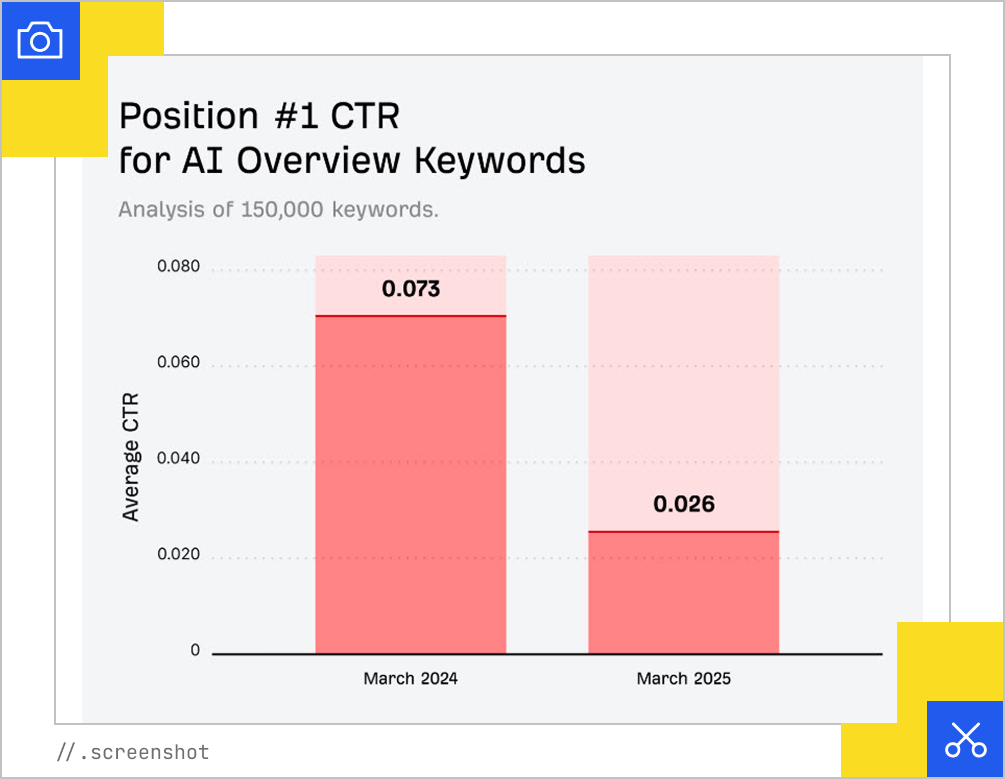
Semrush studied over 10 million keywords across different devices and regions. Their findings revealed:
- 57% of AIOs appeared for long-tail queries, while commercial intent queries saw fewer AIOs.
- Mobile users encountered AIOs more frequently than desktop users.
- Health, Finance, and Tech industries saw the highest appearance rates.
Conductor studied 118 million searches and also found that AIOs still appeared most frequently on informational queries in the Healthcare, IT, and Banking industries.
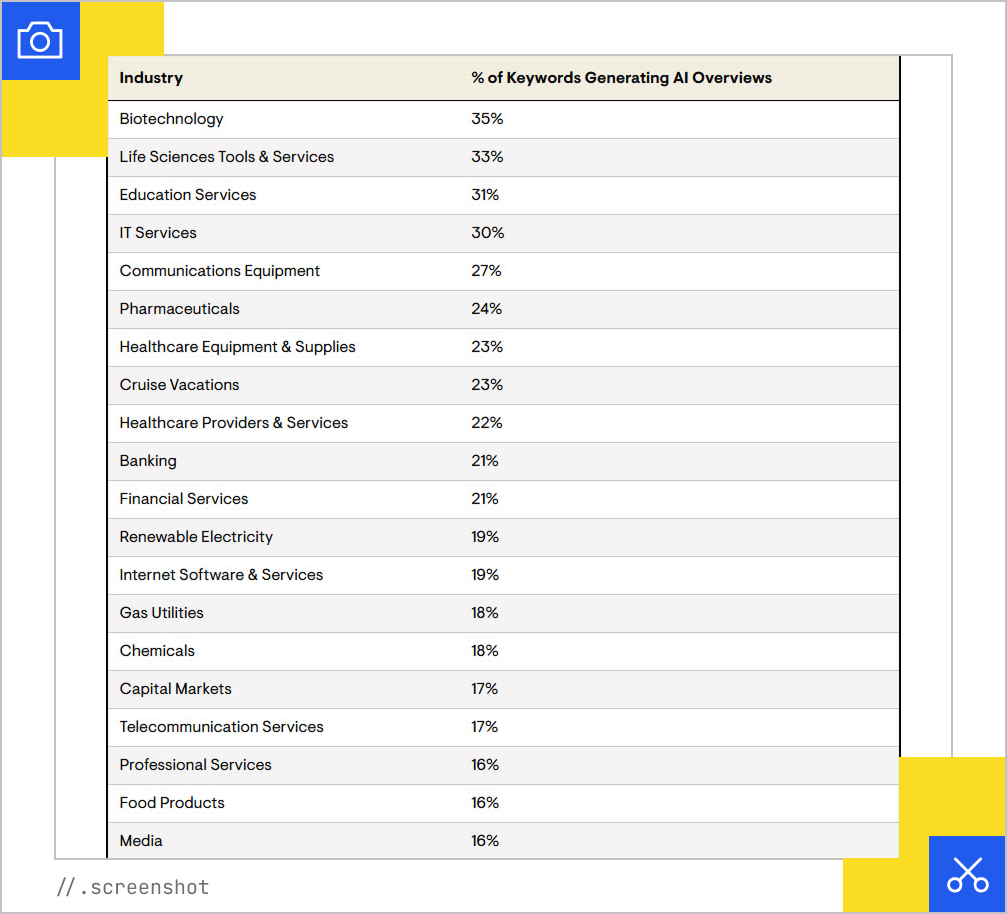
However, they saw a device distribution shakeup with desktop devices accounting for 60% of AI Overviews, up from 13% in April.
One Year of AI Overviews
BrightEdge tracked a year of AI Overviews in a broad, overarching study on how search has changed across industries, queries, and rankings. They found:
- Since the debut of AIOs in May 2024, total search impressions on Google have increased by over 49%, implying that users are searching more frequently and engaging with a broader array of queries.
- CTRs declined by nearly 30%, as users increasingly consume information within the AI Overview itself.
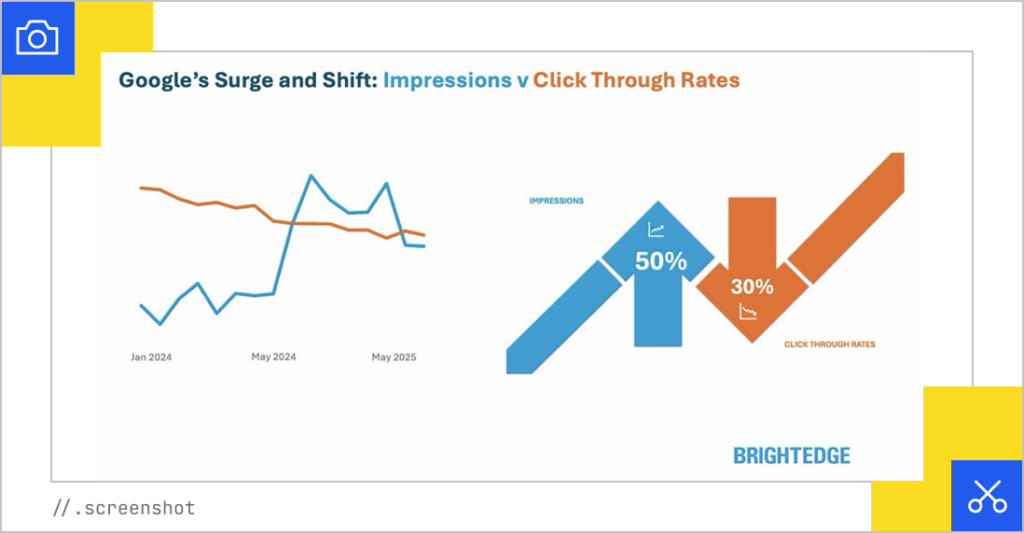
An interesting find was the decline of the once-dominant ranking and comparison queries, which are down 60.5% and 14.5% respectively. This is most likely due to users leaving the ranking to AI nowadays, so rather than searching for something like “best running shoes 2024” they’re simply asking for “running shoes that are best for a 5K” and letting AI rank them.
The study also identified consistently increasing AIOs across Healthcare, Education, B2B Tech, and Insurance, with some nearing 90% in queries by May 2025. This has been the trend from the start and it’s no real surprise since these industries rely on factual, structured content, which AIO summaries often use.
What This All Means: The Implications of AI Overviews
After analyzing over a year of comprehensive research, some clear patterns emerge:
- Traffic Took a Hit: Quick-answer, no-click, informational queries definitely lose traffic, but high-intent or complex queries show varied results. However, traffic in general is going down due to AIOs and that doesn’t seem to be changing anytime soon.
- Traditional Ranking Methods Are Not Enough: The industry was mostly unaware of query fan-out at the time most of these studies were written, but while high organic visibility still matters, query fan-out means content will come from deeper in websites and from a wider variety of related sources. Also, your brand’s strength will contribute a lot to your traffic from now on.
- Intent Optimization Trumps Keyword Optimization: The studies show that matching user intent matters more than exact keyword matching. This may represent a shift in content strategy for many, though the query fan-out for AIOs is less complex than for AI Mode. Try iPullRank’s new tool Qforia for help finding content gaps.
- Relevance Engineering Has Become Critical: Strong user experience, semantic chunking of content, proprietary data, and relevant content significantly improve citation odds. Content creators need to think like relevance engineers.
- User Generated Content is on the Rise: YouTube, Reddit, TikTok and LinkedIn feature prominently in citations, suggesting a more diverse content pool than traditional web pages.
- Evolution Is Constant: AIOs continue to change in design, format, and prominence. What worked six months ago might not work today. And with the addition of AI Mode, things will continue to change.
The data from 2024 and 2025 tells us that AI Overviews aren’t going anywhere at the moment and are becoming a fixture of the search landscape. Publishers and brands need to adapt their strategies to work with it.
Google CEO Sundar Pichai stated on Lex Fridman’s podcast that AI Mode is the future of search. Everything will be rolled into AI Mode (with search revolving around its query fan-out method) to replace the traditional SERPs entirely at some point in the future, so we need to be ready.
That means creating content that’s intent-optimized, format-conscious, and genuinely useful.
But you knew that already, right?

